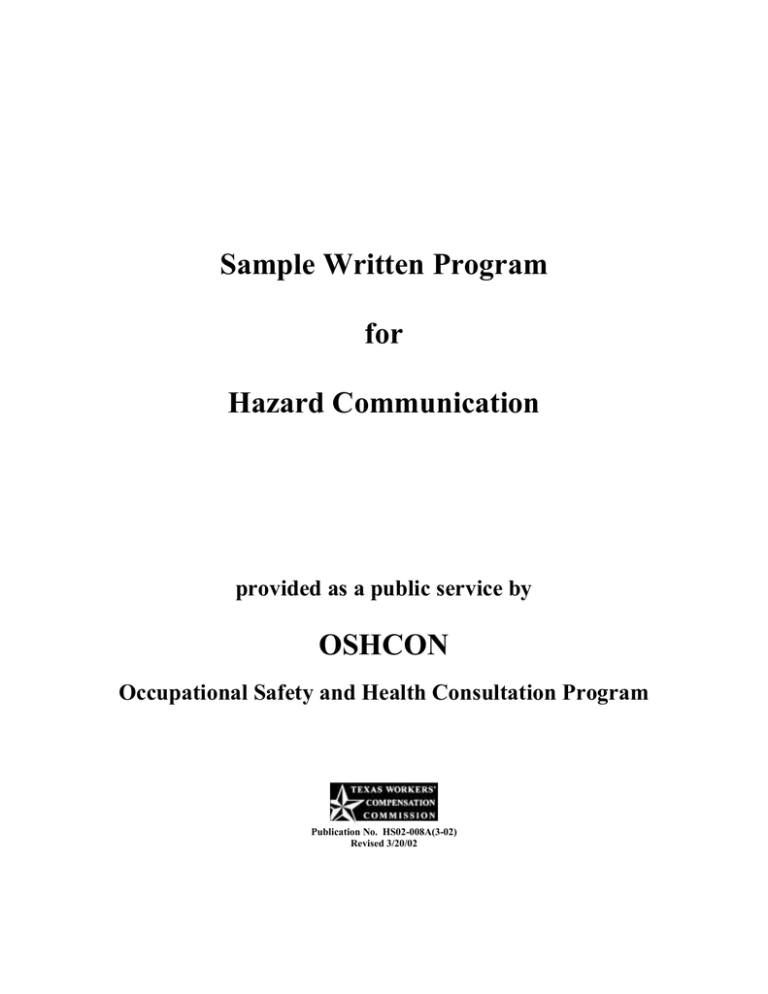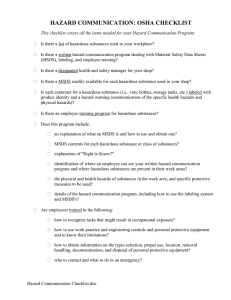Hazard Communication Program Sample | OSHA Compliance
advertisement

Sample Written Program for Hazard Communication provided as a public service by OSHCON Occupational Safety and Health Consultation Program Publication No. HS02-008A(3-02) Revised 3/20/02 1910.1200 Hazard Communication The following hazard communication program is provided only as a guide to assist employers and employees in complying with the requirements of 29 CFR 1910.1200, as well as to provide other helpful information. It is not intended to supersede the requirements of the standard. An employer should review the standard for particular requirements which are applicable to their individual situation and make adjustments to this program that are specific to their company. An employer will need to add information relevant to their particular facility in order to develop an effective, comprehensive program. 2 1910.1200 Hazard Communication Program Table of Contents I. II. III. IV. Objective Assignment of Responsibility Program A. Hazardous Chemical List B. Material Safety Data Sheets (MSDS) C. Labeling D. Training E. Storage F. Non-Routine Tasks G. Other Personnel Exposure (Contractors) H. Program Compliance Attachments A. Acknowledgement of Receipt of Hazard Communication Training Form B. Sample Index/Inventory Roster 3 Company Name Hazard Communication Program I. OBJECTIVE The objective of this program is to set forth policies and procedures concerning Hazard Communications which will enhance the safety and well being of Company Name employees. Furthermore, execution of this program is designed to provide for compliance with the Occupational Safety and Health Administration’s (OSHA) Hazard Communication Standard. II. ASSIGNMENT OF RESPONSIBILITY Responsible person will assume duties as Hazard Communication Officer. This position carries the responsibility of insuring this program is adhered to and that proper reporting is executed. III. PROGRAM The ensuing items are to be followed to insure both compliance with the OSHA Hazard Communication Standard and the safety of our employees. A. Hazardous Chemical List A list of hazardous materials and chemicals which are used in the course of the company's normal business activities must be maintained and continually updated. This list is to include all substances which require a Material Safety Data Sheet (MSDS). One copy of this list is to be kept in the front of each MSDS book and one copy is to be kept on file with the Hazard Communication Officer. For each chemical used in the workplace, an MSDS sheet must be available on that jobsite. B. Material Safety Data Sheets (MSDS) All Material Safety Data Sheets must be kept in an organized fashion and must be placed in an identified and accessible location for all employees to view at will. A duplicate set of MSDS information must be maintained by the Hazard Communication Officer. MSDS books and the Hazardous Chemical List must be maintained and kept up to date. As obsolete MSDS's are replaced by updated copies, they must be retained in a separate file of obsolete MSDS's. Do not throw them away. If a hazardous chemical or substance is received without a proper MSDS, the receiving person must immediately notify the Hazard Communication Officer. The manufacturer or distributor of the product must be contacted immediately and asked to fax the MSDS and mail a copy as a follow up. If, for some reason, the manufacturer or distributor is 4 unable to produce a MSDS upon request, the Hazard Communication Officer should be notified immediately. Hazardous materials or substances received without an MSDS are to be returned to the sender. C. Labeling Each container of a hazardous chemical that is used in or around the work area must be properly labeled with the identity of the hazardous material, the appropriate hazard warnings, and the name and address of the manufacturer. Appropriate labels must be on all containers, regardless of size. Containers must be approved and recommended for storage and/or dispensing of the particular hazardous chemicals contained in them. Worn and torn labels must be replaced. It is the responsibility of employees to report inappropriate labels to their supervisor. It is the responsibility of the Hazard Communication Officer to insure that appropriate labels are in place and that replacement labels are available. Containers for materials that will be used within a particular work shift do not require labels. D. Training Employee training for this Hazard Communication Program consists of the following: 1. Each affected employee working for, or associated with, Company Name is required to review the training material with the Hazard Communication Officer and sign the acknowledgment form which will be placed in the employee’s file. This training is to be done during the new employee orientation process before the new employee actually assumes status as an active employee. In addition to this training, affected employees must be shown the locations of Material Safety Data Sheets, fire extinguishers, first aid kits, and usage and storage of hazardous materials. 2. Fire extinguisher training may be provided to designated employees. An acknowledgment form must be signed by the employee and filed for documentation purposes. 3. First Aid and CPR training will be provided as required in 29 CFR 1910.151. An acknowledgment form must be signed by the employee and filed for documentation purposes. 4. If the management of Company Name engages the services of contract labor personnel, and exposure to hazardous materials is possible, the contract laborers must be made aware of the locations of the Hazardous Chemical List and the MSDS information book. 5 E. Storage All storage areas for hazardous substances are to be secured, properly ventilated, and identified by signs. F. Non-Routine Tasks Before any non-routine task is performed, employees shall be advised and/or they must contact Responsible Person for special precautions to follow and Responsible Person shall inform any other personnel who could be exposed. (No non-routine tasks are known to exist at the time of preparation of this program.) If a non-routine task is necessary, Responsible Person will provide the following information about the activity as it relates to the specific chemicals expected to be encountered: 1. specific chemical name(s) and hazard(s); 2. personal protective equipment required and safety measures to be taken; 3. measures that have been taken to lessen the hazards including ventilation, respirators, presence of other employees(s); and 4. emergency procedures. G. Other Personnel Exposures (Contractors) Responsible Person will provide other personnel or outside contractors with the following information as follows: 1. hazardous chemicals to which they may be exposed to while in the workplace; 2. measures to minimize the possibility of exposure; 3. location of the MSDS and labeling requirements for all hazardous chemicals; and 4. procedures to follow if they are exposed. Responsible Person will contact each contractor before work is started to gather and disseminate any information concerning chemical hazards the contractor is bringing into the workplace, and visa versa. H. Program Compliance Any direct or intentional violation or non-compliance with this program may result in the termination of the person or persons involved, in accordance with company policy. 6 ATTACHMENT A Acknowledgement of Receipt of Hazard Communication Training My signature below acknowledges that I have received training concerning Hazard Communications. I understand that this training fulfills the employee training requirement of OSHA's Hazard Communication Standard. The jobsite and classroom training included the following: 1. Understanding the purpose and scope of the OSHA Hazard Communication Standard. 2. Explanation of the existence of federal, state and local right-to-know laws. 3. Definition of the classification "hazardous chemical". 4. Explanation of situations and elements that must be present for a material to be considered a health hazard. 5. Explanation and interpretation of labels, what is required on all containers, and the Hazard Materials Identification System (HMIS). 6. Understanding and interpretation of Material Safety Data Sheets (MSDS), which must be obtained for each hazardous chemical. 7. My responsibilities as an employee of 8. Policies and procedures to follow in case of exposure. Company Name . ______________________________________________________________________ EMPLOYEE NAME (Please print) ______________________________________________________________________ EMPLOYEE SIGNATURE DATE ______________________________________________________________________ COMPANY REPRESENTATIVE DATE 7 ATTACHMENT B SAMPLE INDEX/INVENTORY INDEX NUMBER 1 PRODUCT Clorox DATE INTRODUCED 04-15-1999 DATE DISCONTINUED 4-12-1998 10-01-2000 USE: Disinfection Janitorial Staff 2 Trained: Jill Smith 04-15-2000 Janet Tide 04-15-2000 Frank Jay 07-11-2000 WD40 USE: Lubricant Maintenance Trained: Henry Late 04-14-2000 8

